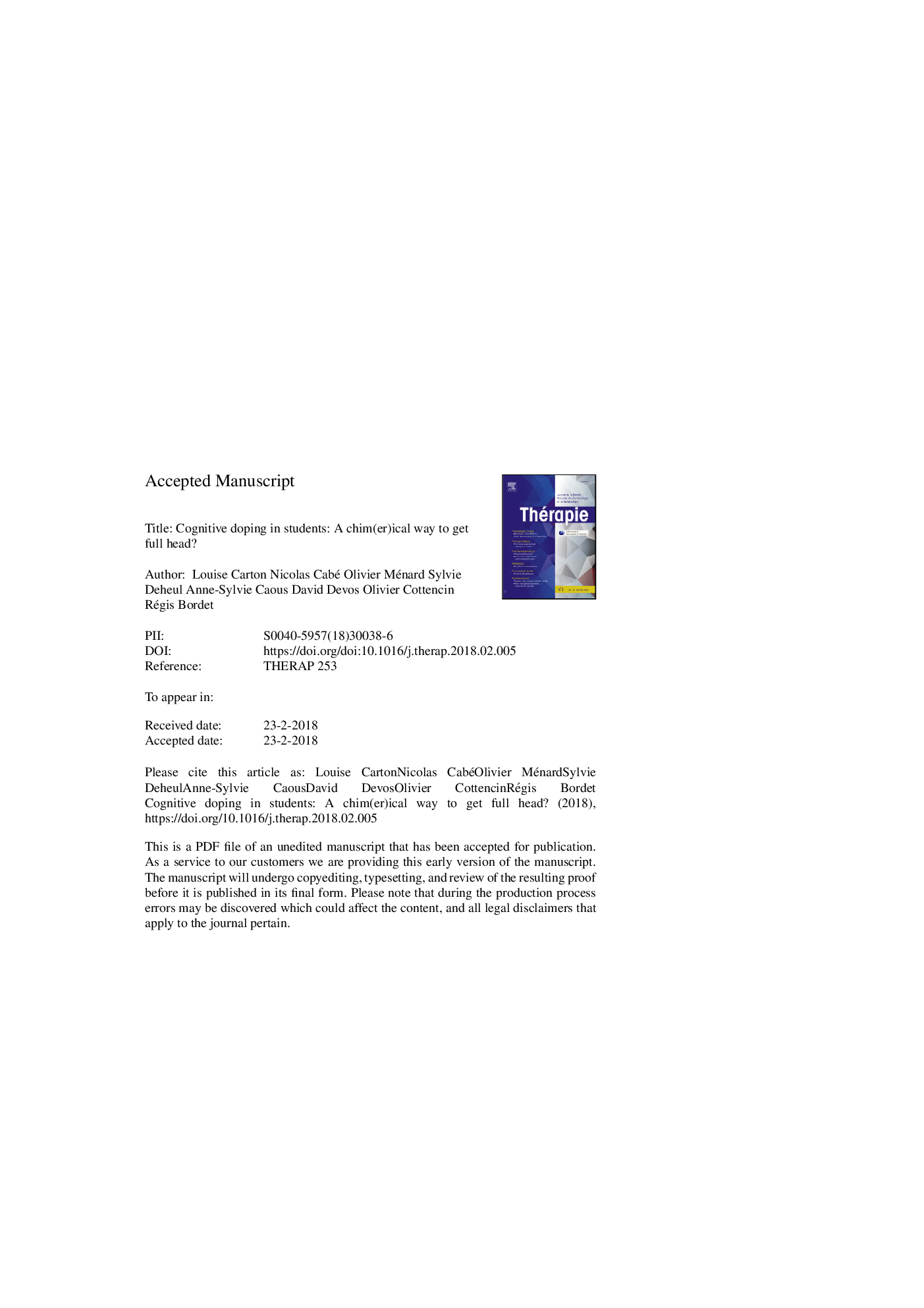| کد مقاله | کد نشریه | سال انتشار | مقاله انگلیسی | نسخه تمام متن |
|---|---|---|---|---|
| 8962392 | 1646577 | 2018 | 17 صفحه PDF | دانلود رایگان |
عنوان انگلیسی مقاله ISI
Pharmaceutical cognitive doping in students: A chimeric way to get-a-head?
ترجمه فارسی عنوان
دوپینگ شناختی دارویی در دانش آموزان: یک راه چابک برای گرفتن یک سر؟
دانلود مقاله + سفارش ترجمه
دانلود مقاله ISI انگلیسی
رایگان برای ایرانیان
کلمات کلیدی
دوپینگ شناختی، دانشجو، روانشناسی متیل فنیدیت، انصاف، ایمنی،
ترجمه چکیده
برای دانشجویان، تقاضای مطبوعاتی برای حفظ، عملکرد بالای سطح و رقابت با همسالان، یک محیط مناسب برای رفتار شناسی دوپینگ دارویی را ایجاد می کند. ما با هدف تعریف رفتارهای اخیر و نسبت سود / ریسک چنین رفتار و بحث در مورد مسائل مورد توجه قرار گرفتیم. شیوع دوپینگ شناختی دارویی در میان دانش آموزان از 1.3٪ به 33٪ در سراسر مطالعات گزارش شده است، با تغییرات بسته به کشور و تعریف دوپینگ شناختی دارویی. طبقات درمانی که اغلب به عنوان اهداف دوپینگ مورد استفاده قرار می گیرند، داروهای روانپزشکی و نوتروپیک هستند (متیل فنیدات، مدافینیل، پیتراتام)، کورتیکواستروئیدها، داروهای آرام بخش و بتا بلوکرها. برخی از مواد غیر قانونی همچون شاهدانه، آمفتامین و کوکائین نیز به منظور تقویت عملکرد ذهنی مصرف می شوند. در نهایت، محصولات غیرفعال مانند قرص های مبتنی بر کافئین یا نوشیدنی های انرژی و یا الکل، همچنین به طور گسترده ای توسط دانش آموزان مورد استفاده قرار می گیرند که انگیزه های آنها شامل افزایش عملکرد، تمرکز، حافظه و بیداری در طول دوره تجدید نظر و امتحان است. با این حال، اثربخشی انتظار (اغلب فریبنده) این محصولات با واقعیت تاثیر منفی متضاد در عملکرد شناختی مطابقت ندارد. به نظر می رسد مشخصات در حال ظهور دانش آموزانی که تمایل به رفتار دوپینگ دارند. بنابراین دوپینگ شناختی، مسئله تنظیم آن را مطرح می کند، باز کردن بحثی علیه، از یک سو، آزادی فردی و مزایای مورد انتظار جمعی، و از سوی دیگر، پیامدهای بهداشت، آموزش (درون) برابری و خطر موفقیت تحصیلات دانشگاهی. تقویت پزشکی مدرسه و دانشگاه، از طریق مبارزات پیشگیرانه و شناسایی افراد در معرض خطر، برای محدود کردن میزان، ریسک و آسیب های مرتبط با چنین شیوه هایی ضروری است.
موضوعات مرتبط
علوم پزشکی و سلامت
داروسازی، سم شناسی و علوم دارویی
فارماکولوژی، سم شناسی و اقلام دارویی (عمومی)
چکیده انگلیسی
For students, the pressing demands for memorization, top-level performance, and peer competition create an environment favorable for pharmaceutical cognitive doping behavior. We aimed to describe recent practices and the benefit/risk ratio of such behavior and to discuss the issues at stake. The prevalence of pharmaceutical cognitive doping among students has been reported from 1.3% to 33% across studies, with variations depending on country and definition of pharmaceutical cognitive doping. The therapeutic classes most frequently cited as being diverted for doping purposes are psychostimulants and nootropics (methylphenidate, modafinil, piracetam), corticosteroids, sedative drugs and beta-blockers. Some illegal substances such as cannabis, amphetamines and cocaine are also consumed in order to boost mental function. Finally, over-the-counter products, such as caffeine-based tablets or energy drinks, or alcohol, are also widely used by students whose motivations involve enhanced performance, concentration, memory, and staying awake during the revision and exam period. However, the expected (often fantasized) effectiveness of these products does not correspond to the reality of a modest controversial impact on cognitive performance. There appears to be an emerging profile of the student more inclined to doping behavior. Cognitive doping thus raises the question of its regulation, opening a debate opposing, on one hand, individual freedom and supposed collective benefits and, on the other hand, health consequences, educational (in)equality, and the risk of tarnished academic success. Strengthening school and university medicine, through prevention campaigns and the identification of subjects at risk, is essential to limit the extent, risk, and damages associated with such practices.
ناشر
Database: Elsevier - ScienceDirect (ساینس دایرکت)
Journal: Thérapie - Volume 73, Issue 4, September 2018, Pages 331-339
Journal: Thérapie - Volume 73, Issue 4, September 2018, Pages 331-339
نویسندگان
Louise Carton, Nicolas Cabé, Olivier Ménard, Sylvie Deheul, Anne-Sylvie Caous, David Devos, Olivier Cottencin, Régis Bordet,
